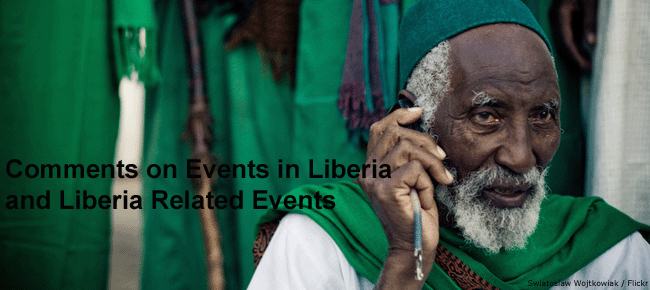Monday, August 25
Some thoughts on the 2008/2009 Budget
On August 5, 2008 the Liberian Legislature agreed on a National Budget of US $ 298 million for the Fiscal Year 2008/2009. This was nearly ten percent higher than the US $ 277 million Draft Budget submitted by the Director of the Bureau of the Budget, Mr. Augustine Ngafua, a few months earlier. As President Ellen Johnson Sirleaf indicated when she commented on the Draft Budget to reporters, the draft budget represented an increase of almost 40 % over the last budget, which was US$199 million. It is interesting to note that the last performance report of the fiscal budget was not yet available when the proposed budget was submitted to the legislators.
More details on the 2007/2008 budget can be found here.
When I read this and after some additional reading, a few comments came to my mind.
(1) When President Sirleaf took office, in January 2006, the budget for FY 2005/2006 amounted to US $ 85 million (yes indeed, eighty-five million US dollars!). In a few years time the Sirleaf Administration managed to raise this to almost US $ 150 million, in FY 2006/2007, and to nearly US $ 200 million in FY 2007/2008. And now the Budget for 2008/2009 has even ‘sky-rocketed’ to nearly US $ 300 million.
Education ranks highest with US $ 27 million (twenty-seven million US dollars), excluding other allotments to the educational sector. Compared to the previous two fiscal years certainly a great improvement (US $ 10 million respectively US $ 15 million), but nevertheless ‘peanuts’ for a school-age population of more than one million. How can Liberia ever achieve the Millenium Development Goals set for education such as 'universal education'?
In fiscal years 2006/2007 and 2007/2008 ‘health’ received US $ 11 million respectively US $ 14 million. In a draft of the 2008/2009 Budget I found on the web some months ago (now apparently removed) it was shown - if I remember well - that for ‘health’ a budget of some US $ 15 million was allocated. To my great surprise, when analyzing the various data, I also discovered that this allocation was lower than the budgetary appropriations for the 30 Senators and the 64 Representatives of the National Legislature.
If this were true, this would mean that less would be spent on the health of the country’s 3.5 million population – according to the provisional data of the 2008 census the population was 3,489,072 on the night of 20th/21st March, 2008 - than for the country's less than 100 legislators, among whom some notorious warlords. Unfortunately, I could not find these data back. Readers who are more informed than I am on the subject are invited to provide the necessary corrections or supplementary data.
(2) According to Liberia’s Poverty Reduction Strategy Paper (PRSP) 2008 – 2011, revenue projections for the coming three years are substantially higher: US $ 550 million (2008/2009), US $ 535 million (2009/2010) and US $ 526 million (2010/2011).
Evidently, there is a great gap between the actual and the desired situation. The deficits will have to be financed by external sources - the international donor community - if Liberia is going to realize its envisaged expenditure levels, in particular for the social sectors (notably health and education). This will undoubtedly result in an increased dependency: 'Never bite the hand that feeds you....’
(3) I could not resist the temptation to compare the National Budget with the budgets of the 1970s, before all the terrible things happened (the PRC coup, the civil war). Between 1972 - 1976 the budgets varied between US $ 80 - 170 million:
US $ 80 mln (1972)
US $ 90 mln (1973)
US $ 104 mln (1974)
US $ 133 mln (1975)
US $ 167 mln (1976)
Source: The Open Door of Liberia - An Economic History of Liberia, p. 354.
Of course, the dollars of the 1970s cannot be compared to the 2008 dollar, and I will certainly not complicate things by introducing concepts such as Purchasing Power Parity (PPP). However, according to the 1976 census Liberia had a population of 1.6 million whereas the provisional results of the 2008 census indicate a population of 3.5 million. This means that the population more than doubled during the last thirty years. This strikingly contrasts with the evolution in the country’s national budget. Not surprisingly, Liberia ranks among the poorest countries of the world. Yet it is well endowed with natural resources. How can this be explained? Who knows the answer?
2008/08/25
Subscribe to:
Post Comments (Atom)


No comments:
Post a Comment